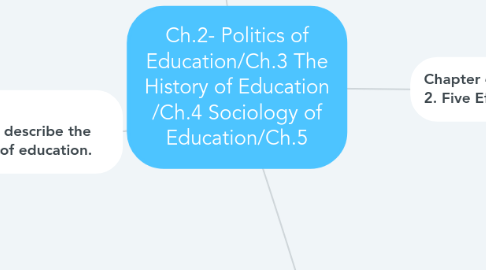
1. Chapter 2 1. Identify and describe the four purposes of education.
1.1. 1. Intellectual-School provides intellectual growth; development of math & reading skills.
1.2. 2. Political- assimilation of immigrants; process that monitors how information received and putting that information with existing knowledge.
1.3. 3. Economic- Job preparation; Doing your when applying for jobs. Know as much background/history as you can about your employer.
1.4. 4. Social- Development of social and moral responsibility; Being up to date on current events in the world
2. Chapter 2 2. Choose and describe a perspective for each of the following: 1) the role of the school; 2) explanations of unequal performance; and 3) definition of educational problems..
2.1. A. Role of the school- To prepare students for challenges of life in the career world. Education must prepare students to think critically and select the opportunities that they need in order to succeed in their chosen path
2.2. B.
2.2.1. B. Explanation of unequal performance- Is largely a social construction. It is handled by both students attributes including gender, race, and class
2.3. C.
2.3.1. C. Educational problems- Road blocks that get in the way or the important elements that we need to focus on in order to move forward and offer better opportunities to the students.
3. Chapter 5 1.Describe the particular world view of one of student-centered philosophy of education (pragmatism or existentialism). Include the following information: generic notions, key researchers, goal of education, role of teacher, method of instruction, and curriculum.
3.1. Goal Education-
3.1.1. Dewey's purpose of education was to comfort and console students to discover all of their power and potential. He wanted to integrate schools and wanted to prepare the students to change the social order into demographic. Primary goal for students will always be their growth. Dewey wanted to students to learn as much as possible to go at out in the world and be successful.
3.2. Pragmatism
3.2.1. Tool for guessing and is reflective of reality. Motivates people to find the process that will ultimately help them be successful. Pragmatists think more about present problems than problems of the past. Pragmatism is all about ideas and how you approach them and make them become major in society.
3.3. Generic Notions
3.3.1. Dewey's ideas were motivated by the theory of evolution and by 18th century had faith in progress. His school became a big part of the community by giving kids the skills and information need to survive in the real world. Teachers focusing on the needs of students is always the number one priority. Letting the students control their own destiny as they go through the learning process.
3.4. Key Researchers
3.4.1. George Sanders Peirce (1839-1914
3.4.1.1. William James (1842-1910)
3.4.1.1.1. John Dewey (1859-1952)
3.5. Role of Teacher
3.5.1. Teacher role is not what it normally would be. In this theory a teacher is more of a monitor. The teacher still advises and helps with the courses of study. Course work is still created/provided by the teacher. A detailed curriculum is what the students should receive. The curriculum is should keep the students on track for the whole school yearTeacher role is not what it normally would be. In this theory a teacher is more of a monitor. The teacher still advises and helps with the courses of study. Course work is still created/provided by the teacher. A detailed curriculum is what the students should receive. The curriculum is should keep the students on track for the whole school year
4. Chapter 4. 2. Five Effects of Schooling
4.1. 1.Employment
4.1.1. Having a degree from a university or college doesn't always guarantee your dream job. Have a degree does provide you with many opportunities of employment. When you have a degree you will tend to make more money than those who don't have a degree.
4.2. 2. Teacher Behavior
4.2.1. Teachers are models for students and, as instructional leaders, teachers set standards for students and influence student self-esteem and sense of efficacy. Persell (1977) found that when teachers demanded more from their students and praised them more, students learned more and felt better about themselves.
4.3. 3 Student Peer Groups and Alienation
4.3.1. Peer groups are all about the "in crowd" and being "cool". Also you have the students with good looks, the athletes with tremendous ability. Alienation comes in when you don't belong to the cool groups of people. Doesn't make you any less special than them but in your peers eyes it means otherwise.
4.4. 4. Gender
4.4.1. 4. Gender- Schools reproduce inequalities is through gender discrimination. Men and women are not equal in society. Men are more likely to get paid more than woman for the same work, and women, in general have fewer occupational opportunities than men. Over the last few decades the gap has closed with females outperforming males in language arts and social studies.
4.5. 5. De Facto Segregation-
4.5.1. 5. De Facto Segregation- Another way that schools reinforce inequalities, particularly racial and ethnic inequalities, is through desegregation. Their are many different scenarios that state why blacks may or may not succeed at segregated schools. Many feel that letting students pick their school choice would break down barriers to end segregation.
